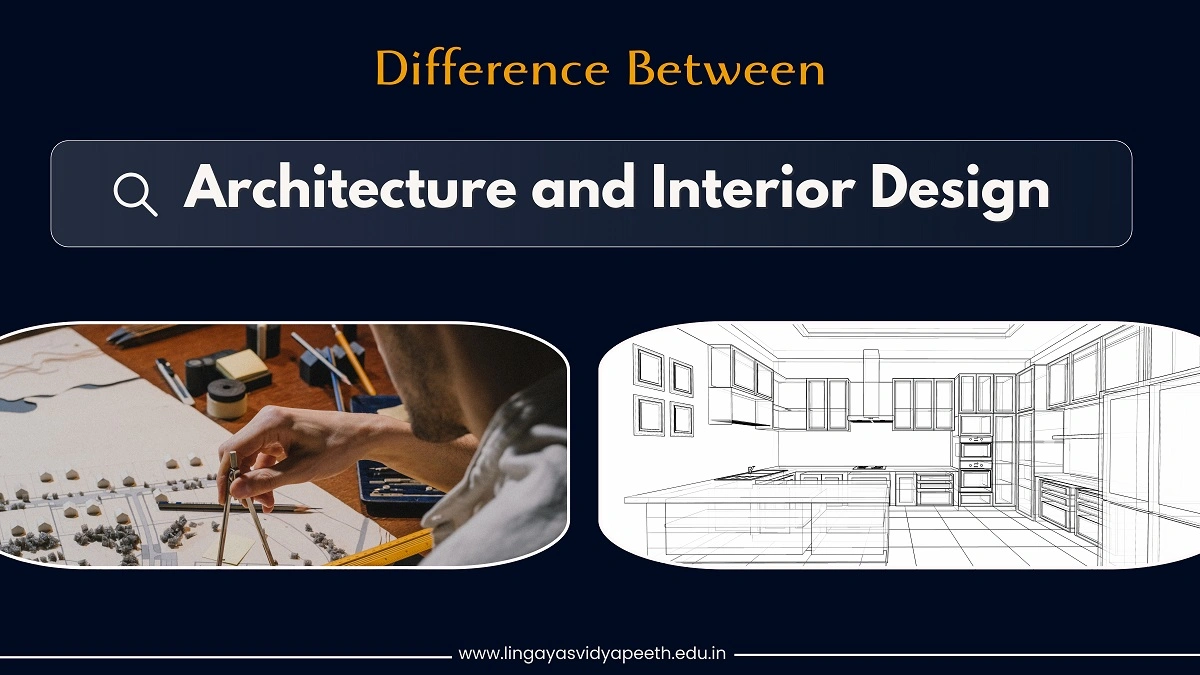Home » Difference Between Architecture and Interior Design

You’ve completed your 12th exams, and now it’s time to decide where your journey leads. If you’re drawn to creating beautiful spaces or designing stunning buildings, you’ve probably heard about architecture and interior design. These fields sound similar, right? But they’re quite different, and choosing between them can shape your future in exciting ways.
In this blog, we’ll learn about the difference between architecture and interior design, explore career opportunities, salary comparison, and help you decide which path might be your calling.
Architects build the skeleton of a building, while interior designers give it personality and life.
To make things crystal clear, here’s a table highlighting the key differences between architecture and interior design:
| Aspect | Architecture | Interior Design |
| Focus | Designing the structure, layout, and exterior of buildings | Enhancing the interior spaces for aesthetics and functionality |
| Scope | Entire building, including structural, technical, and environmental aspects | Interior spaces, focusing on decor, furniture, lighting, and ambiance |
| Education | 5-year Bachelor of Architecture (B.Arch.) degree, often requiring licensing | 3-4 year Bachelor’s degree in Interior Design or related field |
| Tools | CAD, BIM, structural analysis software | Design software (AutoCAD, SketchUp), mood boards, material samples |
| Responsibilities | Site analysis, structural planning, blueprint creation, construction oversight | Space planning, material selection, colour schemes, furniture placement |
| Licensing | Often requires passing exams like NATA or JEE Paper 2 in India | Optional certifications like NCIDQ, not always mandatory |
Both fields offer exciting architecture career opportunities and interior design career opportunities. Here’s a breakdown:
Architects can work in diverse roles, such as:
With India’s real estate market projected to reach $1 trillion by 2030, architecture career opportunities are booming, especially in urban areas like Mumbai, Delhi, and Bengaluru.
Interior designers have a wide range of options, including:
The Indian interior design market is expected to hit $2.1 billion by 2025, growing at a CAGR of 12.1%, creating abundant interior design career opportunities.
Here’s a concise look at architecture and interior design job prospects in India:
Here’s a clear architecture and interior design salary comparison in India:
Choosing between architecture and interior design depends on your interests, skills, and goals. Here’s a quick breakdown to help you make the right choice:
Best For: Students who love math, physics, and designing entire buildings.
Best For: Those passionate about aesthetics, decor, and client interaction.
Architecture Education in India (Focusing on Lingaya’s Vidyapeeth)
For a Bachelor’s in Interior Design:
If you’re leaning towards architecture, Lingaya’s Vidyapeeth is a fantastic choice for your Bachelor of Architecture (B.Arch.). Here’s why:
Deciding between architecture and interior design is all about aligning your passion with your career goals. Both fields offer immense growth, with India’s booming real estate and design markets creating endless possibilities. If you go for architecture then Lingaya’s Vidyapeeth offers robust architecture education in India through its B.Arch. program.
Also Read
Difference between Bcom and Bcom honours
Difference between BBA LLB and ba LLB
Difference between AI and Data Science
Difference between Pharmaceutical and Medical Microbiology
From
Lingaya’s Vidyapeeth
Best university in Faridabad
RECENT POSTS
CATEGORIES
TAGS
Agriculture Agriculture future AI Architecture artificial intelligence Bachelor of Commerce BA English BA Psychology BTech AIML BTech CSE BTech cybersecurity BTech Engineering Business management career Career-Specific Education career guide career option career scope Civil engineering commerce and management Computer Science Computer science engineering Data science degree education Engineering Engineering students English Literature english program Fashion Design Fashion design course Higher Education Journalism journalism and mass communication law Law career Machine Learning mathematics MBA MBA specialization Mechanical Engineering Pharmacy Psychology Research and Development students
Nachauli, Jasana Road, Faridabad, Haryana
Address: C-72, Second Floor, Shivalik, Near Malviya Nagar,
Above HDFC Bank, New Delhi 110017
Landline No. - 011-46570515 / 45138169 / 41755703
Mobile No. - +91-7303152412 / +91-7303152420 / +91-9311321952
Toll Free: 1800-120-4613
Mobile : 8447744303 | 8447744304 | 8447744306 | 8447744309
8700003974 | 8700003411 | 8700003749
Copyrights © 1998 - 2025 Lingaya's Vidyapeeth (Deemed To Be University). All rights reserved.
LV only conducts physical/online verification of any document related to examination on the following email id:
It is important to note that the following email IDs and domains are fraudulent and do not belong to our university.